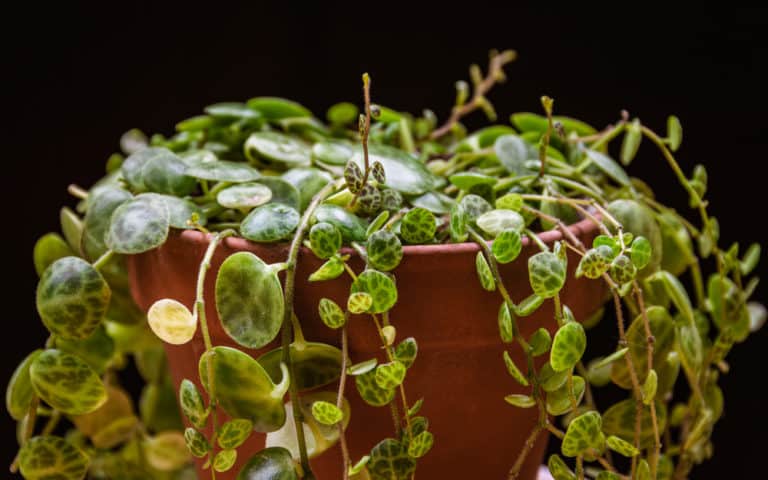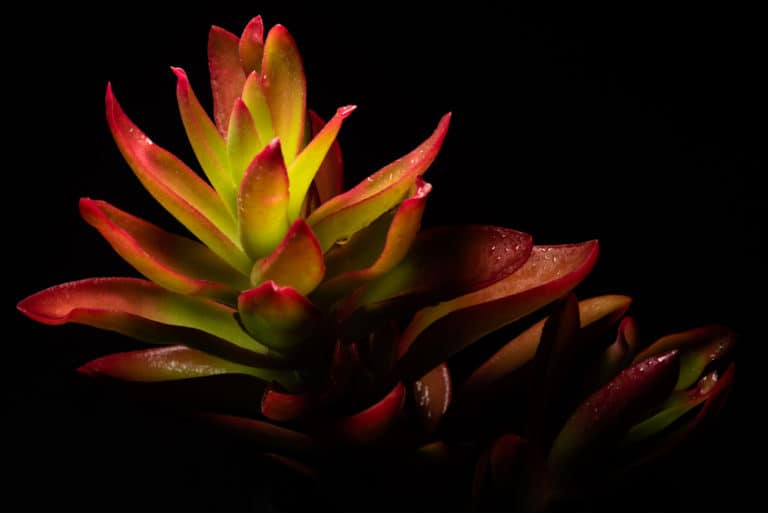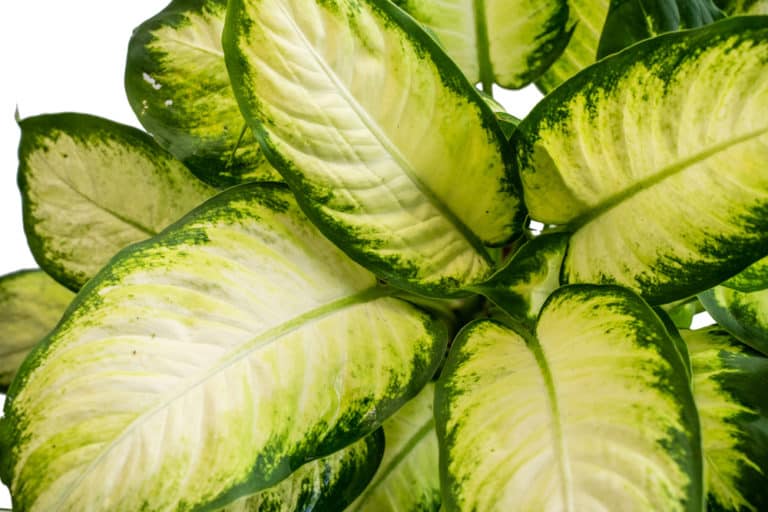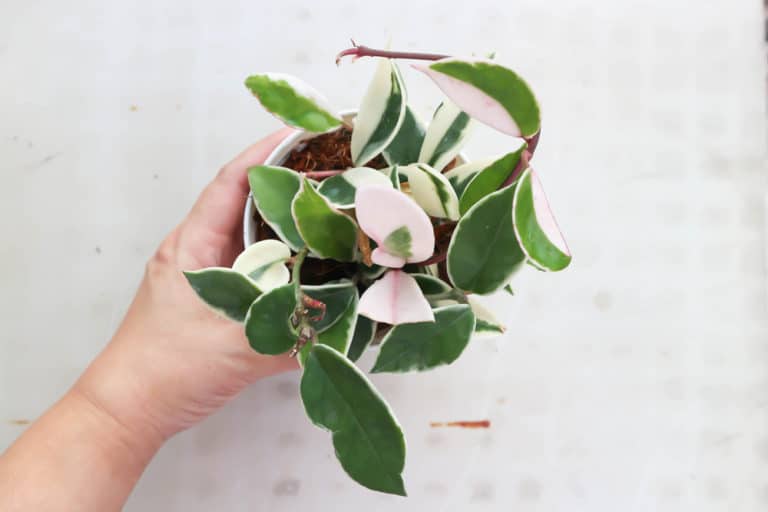Epipremnum Aureum ‘Manjula Pothos’ Care Guide (2024)
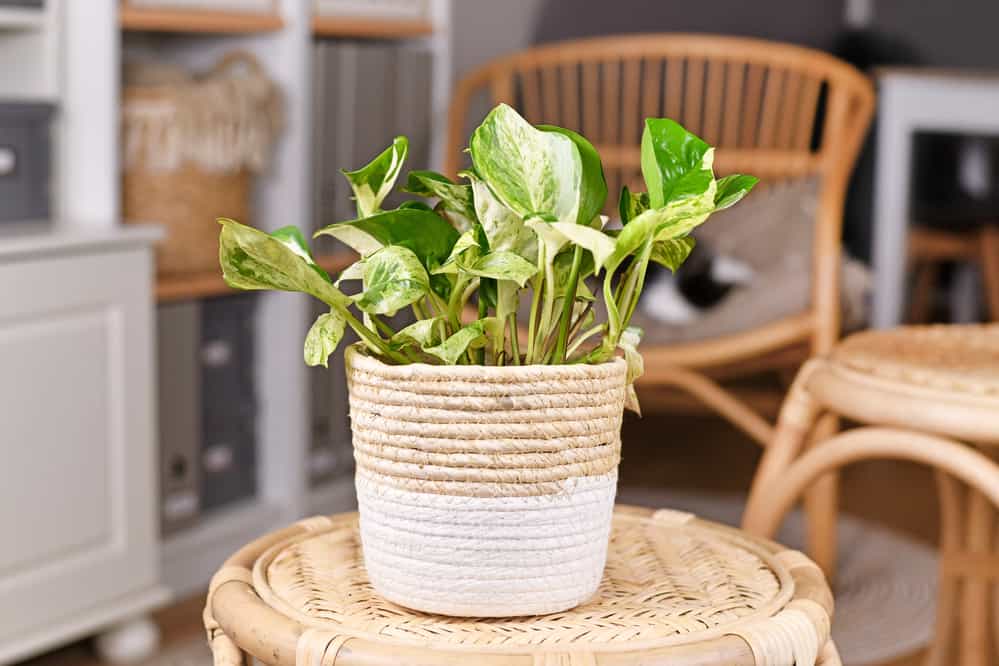
The Epipremnum aureum ‘HANSOTI14’ or the Manjula pothos is a stunning cultivar often mistaken with other two commonly sold plants in the market, the Njoy and Jade pothos. But what sets apart the Manjula plant from all its counterparts is the evidently blissful variegation of each of the large and heart-shaped leaves.
| Scientific Name | Epipremnum aureum ‘HANSOTI14’ |
| Common Name | Manjula pothos, Happy leaf pothos, Jewel pothos |
| Light | Bright indirect light or filtered light |
| Watering | Weekly, when the top 2-3 inches of the soil feels dry |
| Temperature | 70 to 90 °F (21-32 °C) |
| Hardiness Zone | USDA hardiness zone 10-12 |
| Humidity | 60-90 % |
| Soil Type | Rich, loamy and a well-draining mix |
| Soil pH | Neutral (6.1-6.5) |
| Fertilizing | A balanced feed once a month in spring and summer |
| Repotting | Every 1 to 2.5 years |
| Pruning | When the plant becomes root bound |
| Propagation | Stem cuttings |
| Toxicity | Toxic to humans and pets |
| Mature Size | Can grow up to 6 ft. (1.8 meters) tall |
| Bloom Time | Rarely form flowers in cultivation |
What’s Unique About Manjula Pothos?
The Manjula Pothos plant is a lovely specimen characterized by the large, heart-shaped leaves with a creamy to white and green marbling, and a wavy edge.
The plant comes from the Araceae family by which many of the tropical and evergreen perennials are also a member. The variety ‘HANSOTI14’ is a registered patent from the University of Florida but its wild parents are native to the Solomon Islands.
It is no doubt that the Manjula pothos is a highly coveted indoor plant because of its air purifying capacity. The plant may also be grown outdoor but should not be raised under extremely cold conditions.
Manjula Pothos Care
Despite being a rare beauty, the Manjula pothos plant care is quite easy. The plant adores a warm location that receives bright indirect light – helping to maintain its variegation and growth. If you’re in for a tropical adventure, see the guide below and learn more about the basics of Manjula plant care!
Light
The Manjula pothos light requirements consist of bright, indirect light. If grown outdoor, avoid direct exposure to full sun as it can scorch the leaves and thus create irreversible damage.
Note that when growing the plant indoors, lighting is a critical component because a lower light condition reduces the intensity of variegation.
The general rule of thumb with Manjula plant light needs are adequate but not excessive, as this affects the plant’s ability to produce variegation due to increased chlorophyll production.
Pro tip: Place the plant near an east-facing window with curtains to filter some of the light that passes through.
Watering
When it comes to watering needs, the Manjula pothos is quite forgiving, and would easily bounce back should you forget to water the plant as scheduled.
Ideally, Manjula pothos watering should be done once or twice a week, allowing the top two to three inches of the soil to dry out in between cycles. The plant likes moist soil but avoids a soggy condition as this predisposes the roots to rotting and other diseases.
Pro tip: Water Manjula plant as needed during the growing season such as in between spring and summer. Reduce to a minimum when the winter season arrives.
Temperature
As a tropical perennial, the Manjula pothos temperature range is between 60 to 80 °F (16-27 °C). However, the optimum temperature for the plant to thrive and grow best are actually at 70 to 90 °F (21-32 °C).
Considered as having a low-temperature tolerance, the plant grown outside is recommended to be brought inside for protection against extreme cold.
The ideal temperature for Manjula plant is attainable in USDA Hardiness zones 10-12. At the onset of winter, watering is reduced to a minimum, and fertilizing is not needed. It’s also important to note that temperatures above 90°F can greatly retard growth and development.
Humidity
Manjula pothos humidity requirements are not that critical, in fact, most observations point to how flexible it is when it comes to humidity. The humidity level found in most homes typically ranges from 60 to 70 %, differing mildly with the season.
The ideal humidity for Manjula plant is from moderate to high which is usually around 60 to 90%. During colder and drier months, humidity may be increased by the use of a humidifier or a pebble tray. If you’re growing Manjula pothos outside, use a misting spray and apply as needed. You can also group your plants to increase air moisture.
Soil
Like most tropical houseplants, the Manjula pothos soil is preferably loamy and well-draining. A commercially bought soil mix works just fine, but you can also concoct your own soil for manjula plant by mixing an equal proportion of fresh garden soil, perlite, and organic substrates such as peat moss and orchid bark.
Moreover, the recommended ph level for Manjula plant is neutral (6.1-6.5). Avoid a clumpy soil mix that can easily become soggy over time. This not only impedes root growth but can also lead to root rotting.
Pro tip: Make your ideal potting mix by following the 2:1 ratio of peat moss and perlite – increasing both OM and drainage.
Fertilizer
You may find it a relief that the need for Manjula pothos fertilizer is not as crucial as compared to using the right kind of soil. When the appropriate medium is used, it compensates for the need for adding more nutrients to support plant growth.
Nevertheless, giving the plant an extra boost, particularly during the growing season, goes a long way. You can use a typical houseplant fertilizer for Manjula plant with a ratio of either 10-10-10 or 20-20-20.
For best results, apply a balanced liquid fertilizer ratio at least once a month. Especially during summer and spring. Reduce the application with the onset of winter.
Potting & Repotting
The Manjula pothos repotting is done when it has become root-bound and if some of the root segments are already protruding from its current pot. Note, however, that the Manjula pothos has a relatively slow growth rate, so repotting may only be done once every 2 years.
When choosing a container for repotting Manjula plant, choose a pot size twice the original. Gently remove the plant from the current pot, you can either twist slowly from the side or flip the pot upside down and gently push the plant out. Use a fresh potting mix and fill in half of the container. Place the plant in the center and fill in with the remaining soil, and water thoroughly.
Pruning
Trim your Manjula Pothos plants from time to time to maintain their shape and size. Consider this as structural maintenance in order to support new growth and in making the plants appear vibrant.
Cutting Manjula plant back may also be a necessary step when it has been infected with a disease. By removing dead and spent foliage, the plant may revert its energy use to functioning and developing parts.
Manjula pothos pruning is done by cutting the vine at least ¼ inch or 2 to 3 cm above each leaf. Cutting from the node, or the point by which the leaf meets the vine encourages new flushes, and thus promotes a fuller look.
Propagation
The use of stem cutting is the most common and the easiest method for Manjula pothos propagation. The use of cuttings not only enables you to produce a number of new plants but also encourages a much healthier growth of the mother plant.
To propagate the Manjula plant, take a stem cutting directly below a leaf node at least 4 to 5 inches long. Use a cutting with plenty of leaves but be sure to remove some from below, especially on parts that will be submerged in water – as you would later do to encourage root formation.
With any success, you should be able to notice some roots taking form within 4 to 6 weeks. Replant in moist, but well-draining soil under bright indirect light.
Also, make sure to check out our in-depth marble queen Pothos plant care guide.
Common Problems of Manjula Pothos
The evergreen perennial is low maintenance and can survive with a bit of neglect. However, improper cultural management such as overwatering and excessive use of fertilizers can lead to Manjula pothos problems.
Some manifestations of problems with Manjula plants are yellowing and drooping of leaves. This may either be caused by a lack of moisture or the occurrence of pests and diseases.
Pests
A weakening Manjula plant is perhaps showing signs of infestation. Investigate for the occurrence of pests by checking for feeding sites, formation of honeydew, which is often followed by ants, and molds from both the upper and lower side of the leaves.
The most common Manjula pothos pests are spider mites, mealybugs, and scale bugs. They feed on the plant sap which later causes wilting and wounds that may become entry points for bacterial and fungal infection.
Pro tip: Avoid overcrowding and prune the spent foliage or leaves to prevent them from decaying while still attached to the plant. Provide good ventilation, and observe optimum temperature and humidity.
Diseases
Oftentimes, the Manjula pothos diseases are attributed to improper cultural techniques employed. For example, overwatering can lead to the development of botrytis, leaf spot, and root rot. Also, a very humid environment encourages fungal and bacterial growth.
According to the University of Florida, the most common disease infecting Manjula plant is phytophthora root rot, which causes the leaves to turn dark brown to black.
The disease is often introduced through imported propagules, hence the best control is exclusion and pruning off of the infected plant parts. You can also use horticultural oils like neem extract to wipe the leaves to prevent further infection.
Growing Problems
Given the subtropical environment from which the plant originates, the Manjula pothos loves warm and humid surroundings.
However, this is also the optimum condition by which certain diseases caused by bacteria and fungi proliferate. If you’re dealing with a sick plant, check for signs of infestation such as necrosis, spotting, yellowing, and wilting. Avoid overwatering and maintain the optimum humidity requirement.
Growing problems are common no matter how dedicated you are as a plant parent, and so early prevention is done by observing appropriate management techniques, such as the use of sterile equipment, the use of clean propagules, and immediately excluding the suspected plant from other plants.
Toxicity of Manjula Pothos
Most pothos are toxic to both humans and animals, and so it may be expected that the Manjula plant may also have some level of toxicity. This is because, the plant contains calcium oxalate crystals, which are sharp enough to damage the digestive tract and cause mild to severe irritation when ingested
For Humans
Calcium oxalate crystals found in various parts of the Manjula plant can cause mild to severe forms of irritation either when touched or ingested.
The crystals can cause swelling, disruption of the normal digestive cycle, and difficulty in breathing in humans. So it is important to choose a strategic location, such as elevated spots like windowsills and table corners, in order to keep the plant out of reach of small children.
If one happens to ingest a large portion of the Manjula plant, seek immediate medical attention. Other symptoms to watch out for are nausea, diarrhea, skin and mouth irritation, and a burning sensation.
For Pets
Calcium oxalate crystals found in Manjula pothos are similarly toxic to animals. Since most of our furry friends like to run around the house and chew on random stuff that they can get a hold of, you may want to consider a different plant for an indoor setting.
However, having Manjula plants at home may be easily managed by putting the plant away from small children and pets.
If ingested in large amounts, symptoms that may be observed are difficulty in breathing, mouth blistering, frequent and painful urination, presence of blood in the stool or urine, and restlessness. If any of these symptoms appear, have your pet checked by a veterinarian.
Manjula Pothos Appearance
The distinct Manjula pothos appearance is attributed to the highly variegated leaves with a shade of silver, cream, and lemon green. These colors are randomly mixed and usually begin in the center of the leaves and then, later on, spread to the upper side, adding to the plant’s aesthetic value.
Foliage
The foliage of Manjula pothos is what makes it ultimately stand out from other varieties and similar plants. The plant features a wide set of heart-shaped light green leaves with creamy to silver-white variegations. The leaves are randomly shaped and some have large patches in shades of green to off-white.
Each leaf of the Manjula plant have a textured surface that waivers and appears almost frilly. The plant can retain its green color and may even revert to a solid green upon continuous exposure to excessively bright light. This is due to the increased production of chlorophyll that gives no room to pigmentation.
Flowering
There is little information regarding the Manjula pothos flowering and their structure, this is because the plant does not usually flower when cultivated, particularly when grown in an indoor setting.
Oftentimes, the juvenile phase of the plant is what is being sold in the market, and the blooming period would only occur upon maturity.
But in their wild habitat, the Manjula pothos flower is held together by a number of erect flower stalks with creamy spathe having a tinge of purple along the spadix.
Flowering is the least concern when growing Manjula plants, but when they appear, it’s always spectacular scenery.
Size and Growth
Even when grown indoors, the size of Manjula pothos can go up to 6 ft. or 1.8 meters tall. The leaves are measured at 7 to 8 cm long and 5 cm wide. The plant has a relatively slow growth rate, so it does not come as a surprise that repotting of the plant is usually done every 2 years.
As compared to other varieties of pothos, the Manjula plant has larger leaves and a bushy growth habit that intensifies over time, hence pruning is observed. It may also display a vining habit which is often influenced by the kind of container used.
Manjula Pothos Fragrance
Interestingly, the name Manjula comes from the word ‘manju’ which is a Sanskrit word for pleasant and sweet. Ideally pertaining to the Manjula pothos fragrance that is perceived by growers. The scent in general resembles the fruity smell of apple.
Moreover, the Manjula pothos are able to emit compounds that can remove harmful toxins and pollutants from the air, making it advantageous to have the plant at home.
The flowers, which rarely occur, are also reported to have a sweet smell and are stronger when in full bloom. Some may also have caught a refreshing whiff coming from each of the vines.
Suggested Uses for Manjula Pothos
The Manjula pothos is a staple plant for indoors if you wish to invite that tropical vibe. Add to that, the plant thrives in the normal condition found typically in most homes. Such as low to medium light, moderate to high humidity, and warm ambient temperature.
The plant often serves as a specimen for a tropical garden, a vining structure for a hanging basket, and a green ornament for corners and tabletops.
If grown outdoors, the plant can withstand a few temperature extremes but will grow best in shady areas with a fair level of humidity and cold. With the use of a trellis, the plant makes for an attractive and low-maintenance design element.
FAQ
What is Manjula Pothos?
The Manjula pothos ‘HANSOTI14’ is a stunning cultivar patented by the University of Florida and is among the perennials with a vining habit that are great for an indoor setting.
How to identify Manjula Pothos?
The Manjula Pothos plant is a lovely specimen characterized by the large, heart-shaped leaves with a creamy to white and green marbling, and a wavy edge.
How to care for Manjula Pothos?
Grow your Manjula plant under bright indirect light. Choose a warmer spot with 60-90 % humidity. Water when the top inch of the soil feels dry to the touch.
How to grow Manjula Pothos indoors?
Choose a bright location, ideally near an east-facing window. Grow the plant on a rich and well-draining substrate. Allow to dry out in between watering.
How to grow Manjula Pothos outdoors?
Choose a sunny spot but ensure that the plant will receive some afternoon shade to avoid leaf scorch. Water when the top inch of the soil dries out.
How fast does Manjula Pothos grow?
The Manjula pothos has a relatively slow growth rate. However, with the right growing condition, the plant may reach up to about 8-12 inches per month.
How tall does Manjula Pothos grow?
The size of Manjula pothos can go up to 6 ft. or 1.8 meters tall. The size of the leaves is roughly 7 to 8 cm long and 5 cm wide.
How to make Manjula Pothos grow faster?
For faster growth, you may apply a balanced fertilizer for 2-3 weeks with a ratio of 10-10-10 or 20-20-20 during the growing season – particularly during summer and spring.
How to stake Manjula Pothos?
Put a stake in the center of the pot. Remove any plant debris and leave for a few weeks to allow the plant to attach to the stake for support.
How to pot Manjula Pothos?
Fill the container with half of the potting mix, place your Manjula plant gently into the center of the pot, fill in with the remaining medium, and water thoroughly.
How to revive Manjula Pothos?
Bring back your Manjula pothos to life by trimming damaged, spent leaves, and flowers. Ensure that the container has sufficient drainage and apply fertilizer as needed.
Why is my Manjula Pothos dying?
Improper cultural management may cause the Manjula plant to lose its vibrance. Investigate pest infestation and disease occurrence. Prune the parts of the plant that do not function.
Why is my Manjula Pothos drooping?
Overwatering and underwatering may be the culprit for your Manjula plant’s drooping leaves. You should also investigate for signs of disease for immediate treatment.
How cold can Manjula Pothos tolerate?
The Manjula pothos does not have a low-temperature tolerance and may suffer from extreme cold. Temperatures above 90°F can greatly retard growth and development.
How to get rid of pests on Manjula Pothos?
Some of the natural means to get rid of pests are the use of horticultural oil such as citronella and neem oil. It’s also a good practice to regularly wipe the leaves.
Is Manjula Pothos toxic to cats?
Yes. The Manjula cultivar, like most pothos found in the market, contains calcium oxalate crystals which may cause an adverse reaction such as blood in urine and severe discomfort.
Is Manjula Pothos toxic to dogs?
Yes. The Manjula plant has calcium oxalate crystals that if ingested in large amounts can cause skin and mouth blisters, blood in urine, and restlessness.
Is Manjula Pothos toxic to children?
Yes. The Manjula plant has calcium oxalate crystals that are equally toxic to both adults and children. They can cause skin and mouth irritation, difficulty in breathing, and diarrhea.
Is Manjula Pothos toxic to humans?
Yes. The Manjula plant has some level of toxicity due to the presence of calcium oxalate crystals that if ingested in large amounts can cause an adverse reaction.
Does Manjula Pothos have a scent?
The Manjula pothos is reported to have a scent resembling the fruity smell of apple. While the flowers and vine have a generally sweet smell.

